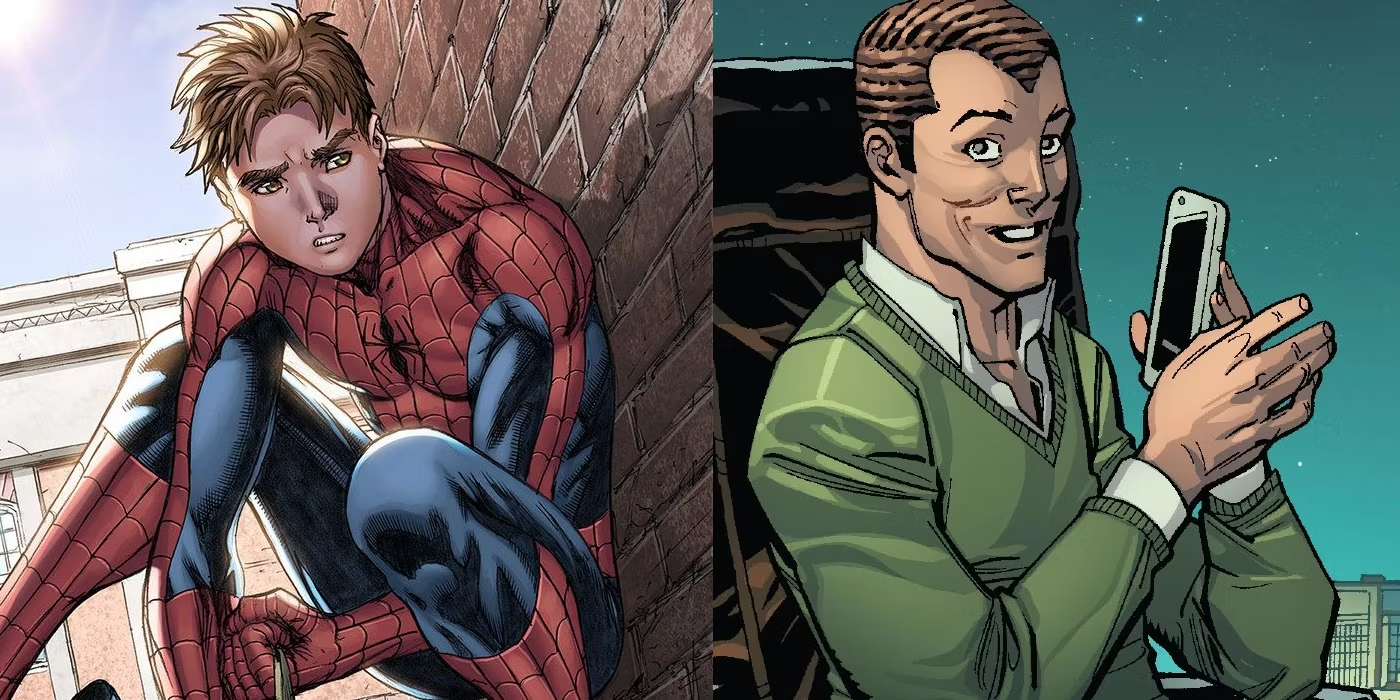
I have written several articles about Peter Parker/Spider-Man. I briefly mentioned him in my very first post about the early creation of Marvel superheroes. More recently, I wrote about his continued presence as a fan favorite. We then took a look at his love life, his job at the Daily Bugle, the super villains he has faced, specifically The Green Goblin. There is another person in Peter’s life that is very important: He had a best friend, who was also the son of Spider-Man’s worst enemy.
Today, I’m going to be talking about that character who’s had quite the journey in the world of Marvel Comics: Harold Theopolis ‘Harry’ Osborn. Created by the legendary duo of writer Stan Lee and artist Steve Ditko, Harry entered into Peter’s world in The Amazing Spider-Man #31, “If This Be My Destiny…!” , published in December 1965. With his introduction in Spider-Man’s expansive universe, Harry brought complexities and depth from his first appearance. How is it that Spider-Man and Harry Osborn went from friends to foes?
Harry’s narrative is a tale of personal struggles and family drama. Born to Norman Osborn, the fearsome Green Goblin, and his wife Emily Lyman, Harry’s life was marred by tragedy from the start. His mother’s weakened state and eventual death following his birth set the stage for a tumultuous relationship with his father, Norman, who became distant and harsh in his grief.
In the creative hands of Lee and Ditko, Harry’s story did more than offer an emotional backdrop; it established a foundational relationship that would evolve dramatically over the decades. Through his trials and tribulations, Harry Osborn served as a mirror to Peter Parker, reflecting the delicate balance between personal hardship and the hero’s duty.
Beginnings of a Troubled Friendship
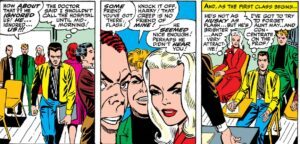
Harry Osborn’s entry into Peter Parker’s life at Empire State University started on a rocky note. With a cloud of elitism perceived by some due to his wealthy background, Harry initially accused Peter of snobbery. This accusation stemmed from his misunderstandings about Peter’s reserved nature, which was mistaken for aloofness. However, things weren’t as Harry presumed.
Fate had its way of weaving complex relationships. Through shared experiences and social circles that included Gwen Stacy and Flash Thompson, Harry’s misjudgments began to clear. A confrontation led to clarity when Harry discovered Peter’s quiet demeanor was not due to arrogance but rather concern for his Aunt May’s health. It was this turning point that brought down the walls between them, paving the way for a strong friendship to develop.
The friendship’s growth was not just a case of overcoming misunderstandings. As time went by, the two found common ground and mutual respect. This camaraderie ultimately proved to be one of the great ironies of the Spider-Man lore, as their destinies would intertwine in ways neither could anticipate at the time.
Harry’s transition from antagonist to ally in Peter’s life was a subtle reminder of the multifaceted nature of human relationships. Their evolving bond, marked by reconciliations and revelations, set the stage for the crucial role Harry would play in Peter’s journey — both as a support system and, ultimately, as one of his greatest adversaries.
The Dynamics of Roommates and Careers
Once adversaries turned allies at Empire State University, Harry Osborn and Peter Parker expanded their friendship into a living arrangement, prompted by Harry’s affluent father, Norman Osborn. The dynamic within their shared space often mirrored the complexities of their individual lives. Harry, carrying the weight of his father’s expectations, encouraged Peter to take up work at OsCorp, Norman’s brainchild. Peter was, at first, reluctant to take the job, because he knew Osborn was the Goblin. Equally important, Norman also knew that Peter was Spider-Man, making Osborn the only villain privy to the identity.
The potential benefits of such employment for Peter were significant. By courting the favor of the influential Norman Osborn, Peter gained access to cutting-edge technology and resources – a decision influenced by a blend of friendship and necessity. Jobs like those at OsCorp could help Peter support his beloved Aunt May, and the opportunity seemed a golden one at the outset.
However, the challenges were as multifaceted as the benefits. Peter’s secret life as Spider-Man added layers of complication to his relationship with Harry and Norman. His responsibility to conceal the truth of his alter ego came with a heavy burden, especially as Spider-Man often found himself in conflict with Norman’s own villainous alter ego, the Green Goblin.
Despite their strengthening bond, shadows lingered behind the camaraderie. Peter’s efforts to protect his friend from the harmful truth of his father’s dark side created a delicate tightrope walk between his dual identities. The stakes of their intertwined lives were far greater than any term paper or final exam, marking a pivotal era in their evolving friendship.
Love Interests and Personal Struggles

Emerging from the shadow of their academic and extracurricular pursuits, the personal lives of Harry Osborn and Peter Parker began to intertwine with complex romantic entanglements. Harry was first to capture the heart of Mary Jane Watson, a vivacious character introduced by Stan Lee and John Romita Sr. Despite Harry’s burgeoning relationship with Mary Jane, the true depth of his emotional strife began to surface.
Peter, on the other hand, found himself drawn to Gwen Stacy, created by the same iconic duo. As their relationships unfolded, the webs of romance only added to the already tangled life that Peter led as Spider-Man. Harry was oblivious to the double life his roommate veiled, a secret kept to shield Harry from the harsh truth of his father’s villainous alter-ego, the Green Goblin.
Yet, Harry’s struggles extended beyond the dramas of love and friendship. Starting with Amazing Spider-Man #96 and following issues by Stan Lee with art by Gil Kane, penned by Stan Lee with art by Gil Kane, the storyline tackled a then-controversial topic: drug abuse. The narrative threw Harry into a harrowing battle with addiction, a reflection of the societal issues of the time.
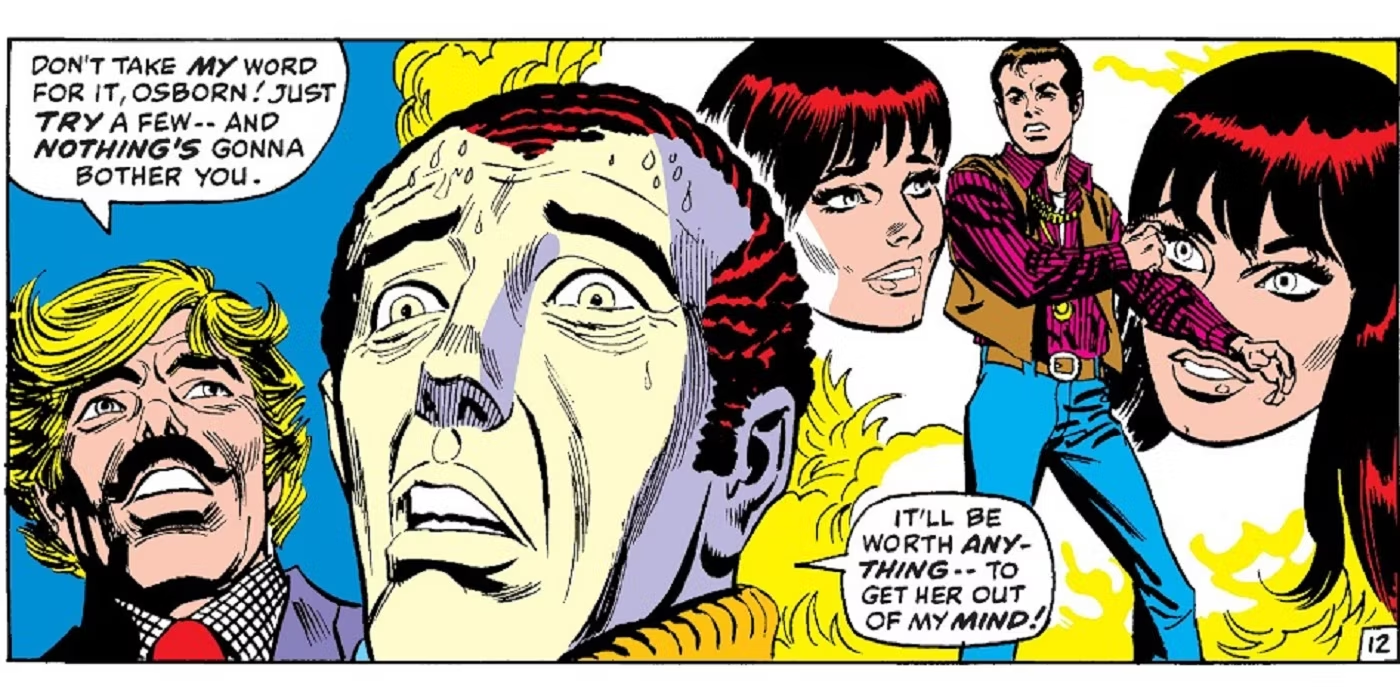 The fallout from Harry’s substance abuse strained every facet of his life, most notably his relationship with Mary Jane. Her decision to end their romance mirrored the inevitable destruction that addiction wreaked upon personal connections, leaving Harry to contort under the weight of his own decisions and vulnerabilities. The impact of these events set the stage for a much darker journey, compelling the narrative forward toward Harry’s eventual donning of the Green Goblin costume.
The fallout from Harry’s substance abuse strained every facet of his life, most notably his relationship with Mary Jane. Her decision to end their romance mirrored the inevitable destruction that addiction wreaked upon personal connections, leaving Harry to contort under the weight of his own decisions and vulnerabilities. The impact of these events set the stage for a much darker journey, compelling the narrative forward toward Harry’s eventual donning of the Green Goblin costume.
The Birth of a Nemesis
 The trajectory of Harry Osborn took a harrowing turn with the events leading up to and following The Amazing Spider-Man #122. This issue depicted the death of his father, Norman Osborn, also known as the Green Goblin, at the hands of Spider-Man – a pivotal event crafted by writer Gerry Conway and artist Gil Kane. The demise of Norman Osborn not only left a void in Harry’s life but also marked a critical juncture in the Spider-Man narrative. Conway’s decision to weave Harry into the Green Goblin’s legacy was not merely for dramatic effect; it was a bold statement addressing the destructive inheritance of family legacies and the psychological scars they leave.
The trajectory of Harry Osborn took a harrowing turn with the events leading up to and following The Amazing Spider-Man #122. This issue depicted the death of his father, Norman Osborn, also known as the Green Goblin, at the hands of Spider-Man – a pivotal event crafted by writer Gerry Conway and artist Gil Kane. The demise of Norman Osborn not only left a void in Harry’s life but also marked a critical juncture in the Spider-Man narrative. Conway’s decision to weave Harry into the Green Goblin’s legacy was not merely for dramatic effect; it was a bold statement addressing the destructive inheritance of family legacies and the psychological scars they leave.
Harry’s transition into the Green Goblin was not instantaneous but sprouted from the seeds of anguish, neglect, and a quest for vengeance. When Green Goblin was impaled with his own glider, the event was secretly witnessed by Harry. He removed the villain costume from his father to protect his father’s identity. Unable to cope with the loss of his father, whom he idolized despite his faults, Harry slowly became consumed by the same rage and madness that plagued Norman. When Harry donned the Green Goblin costume, he also took on the mantle of his father’s alter-ego and all the complexities that came with it. This watershed moment in Amazing Spider-Man #136 is a testament to Conway’s narrative ingenuity, showing us how closely the lives of heroes and villains are intertwined.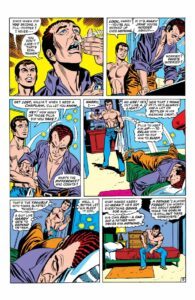
The transformation of Harry into a villain was foreshadowed by his struggle with drug abuse, as seen in The Amazing Spider-Man #96-98, groundbreaking issues that defied the Comics Code Authority by addressing the topic of narcotics head-on. The depth of Harry’s character was further fleshed out when his relationship with Mary Jane Watson deteriorated due to his increasingly self-destructive behavior. The usage of drugs became a narrative tool to explore deeper societal issues and individual turmoil, setting the stage for Harry’s downward spiral.
The emergence of Harry as the new Green Goblin reshaped his relationship with Spider-Man. No longer merely a friend or a bystander, Harry’s character was now a mirror to Peter Parker – a reflection of what could go awry when personal demons overtake reason and when the weight of legacy becomes unbearable. This shift from friend to foe was a poignant evolution in the Spider-Man series, underscoring the theme that the most profound conflicts often come not from strangers, but from those we love.
The Evolution of Harry Osborn’s Character
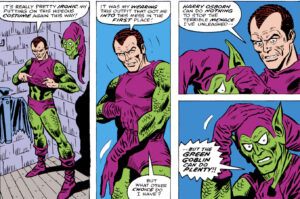
Harry Osborn’s journey has been anything but ordinary. From the joys of friendship to the depths of villainy, his transformation has left an indelible mark on the Spider-Man lore. Witnessing his character evolve over time provides not just drama and conflict, but also a reflection on how the burdens of legacy and personal trauma can reshape a person.
Throughout various story arcs, Harry’s interactions with notable characters in the Marvel Universe have continually added layers to his persona. His struggle to both uphold and break free from his father’s shadow is a recurring theme that speaks to readers on many levels.
The complexity of Harry’s character, swinging like a pendulum between antagonist and victim, enriches the narrative of the Spider-Man comics. His tragic path from Norman Osborn’s scorned son to a troubled friend, and ultimately a foe of Spider-Man, showcases the storytelling prowess of Marvel’s writers and artists across generations.
For us readers, the evolution of Harry Osborn offers more than just entertainment; it’s a mirror held up to the challenges we all face in confronting our personal demons and family legacies. Whether he’s threading the fine line of morality as a businessman or donning the mantle of the Green Goblin, Harry remains one of the most complex characters in comic book history.
Ultimately, Harry Osborn’s story is one of potential and downfall, of choices and circumstances that led him down a twisted path. He remains a testament to the grey areas in storytelling where heroes and villains are not just born, but made through life’s unpredictable journey.
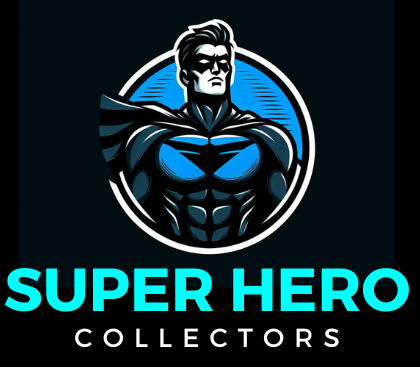
Hey there,
Your post delving into the complex dynamics between Spider-Man and Harry Osborn is a captivating read! From their initial friendship to the eventual transformation into enemies, the evolution of their relationship is filled with twists and turns. The detailed analysis of their motivations and conflicts sheds light on the depth of their characters and the impact it has had on the Spider-Man storyline. Fans of the web-slinger will definitely appreciate this in-depth exploration. Thanks for sharing this fascinating piece!
Marios
Welcome back, Marios! Thank you for reading and leaving a comment.
– Scott
Hey Scott,
This article on Spider-Man and Harry Osborn’s dynamic is fascinating. Still, I am a bit curious about:
Did Harry’s transformation into a foe inevitable, given their history?
How do you feel about how their friendship evolved in different adaptations, like the comics versus the movies?
Also, is there a chance for their relationship to reconcile, or is the damage too deep?
Such an intriguing and complex relationship adds depth to both characters. Can’t wait to hear your thoughts.
Hi Sara,
Welcome back! I’m happy you enjoyed the article and that it raised some questions!
Inevitable? Yes, given their history, his transformation does seem inevitable. Harry’s desire to seek his father’s approval, coupled with Norman Osborn’s disdain for Peter set the state for conflict. When Harry discovers that his best friend is also his father’s greatest enemy, it creates an irreconcilable internal conflict. This turmoil, fueled by his feelings of betrayal and his father’s influence, makes his turn to villainy almost a natural progression in their story arc.
I have found their story in different media to be interest. Their relationship definitely evolved in different ways. In the comics, their relationship was deeply explored, but was retconned in different story arcs, such as The Amazing Spider-man, Spectacular Spider-Man, Spider-Man Worldwide, Ultimate Spider-Man. They all evolved in different ways, depending on the comics’ authors. Some critics don’t like the changes that have been made throughout the course of the decades. I have found the differences to be interesting, but also sometimes confusing. Even the different movie trilogies depicted their friendship in different ways.
The potential for reconciliation is a theme that’s explored with varying outcomes across different media. In some comic storylines, Harry does find moments of clarity and attempts to make amends, but these are often short-lived due to his unstable mental state and the lasting impact of his father’s legacy. The movies also touch upon this, particularly in Spider-Man 3, where Harry sacrifices himself to save Peter, suggesting that at the core of their rivalry, there remains a deep bond.
Thanks again for your insightful questions. This dynamic is truly one of the cornerstones of Spider-Man’s world, and discussing it only highlights how much depth and emotional complexity it brings to the narrative.
Come back soon!
– Scott
I used to read spider man comics avidly when I was a kid, but I had forgotten this part of the story and how Harry and Peter used to be friends before Harry changed into something bad.
Looking at his background it was hardly surprising.
I can’t remember, but did Harry ever find out that Peter was actually Spider Man?
HI Michel,
Welcome back and thanks for joining the discussion. Yes, Harry did find out that his friend Peter was Spider-Man. In the Amazing Spider-Man comics, Harry found the Spider-Man costume in Peter’s room in their shared apartment.
Please come back again!
– Scott
Great article, Scott! I really enjoyed the deep dive into Spider-Man and Harry Osborn’s complex relationship. It’s fascinating how personal struggles and family drama turned Harry from a close friend into one of Spider-Man’s most formidable foes. This piece highlights the rich storytelling that makes the Spider-Man comics so captivating.
Hi Amanda!
Thank you for your kind words. I have found the depth of the Spider-Man story to be very engaging. I’m glad that you do, as well.
Please come back for more superhero fun!
– Scott
Wow! This article is fascinating! I loved your analysis of the evolving relationship between Peter Parker and Harry Osborn. I felt very invested.
Although, I have to confess to never having read the Spider-Man comic books and my only experience of Spider-man is through the films but your insight into the dynamics of these two relationships was intriguing and encourages me to read more.
My son-in-law is into Marvel comic books and graphic novels and I can’t wait to show him this post and discuss it with him further.
Thanks again
Elaine
Hi Elaine!
Thank you for coming to my site and reading this post about Spider-Man and Harry. I’m glad that it was intriguing enough for you to read, even though you are admittedly not a Spider-Man reader. Yes, please share this with your son-in-law. I hope he enjoys, as well.
Please come back for more superhero fun!
– Scott
The relationship between Peter Parker and Harry Osborn and then between Spiderman and the younger Green Goblin is a flection of the intricate complexities of human relationships particularly as both were complex individuals in themselves.
I really found this historical narrative of their relationship to be enlightening. What I erroneously had in memory was that the relationship between Peter and Harry became complicated first because of their affections for and relationships with Gwen Stacy. The second reason stemmed from Spiderman’s involvement in the passing of Norman Osborn, the older Green Goblin.
This post made for very interesting reading for me.
Oluseyi,
Welcome back! Thanks for your comments. I’m glad you found this interesting and gave you a good timeline on their history.
Keep coming back for more superhero fun!
– Scott
Really great article thanks for sharing Scott! I love Spider-Man, he’s one of my favourite superheroes both in the Comics and Movie and while I love Green Goblin as a foe to Spider-Man my favourite was/is Doctor Octopus. I will admit though Willem Dafoe’s performance as Green Goblin in the movies was absolutely incredible.
I’d like to ask your opinion the impact witnessing his father’s death had on Harry, he was already on a dark road but do you think seeing his father die created a point of no return for Harry? Do you think had he not witnessed it he may have found a way out of the route he was heading or was it always inevitable he would turn out this way?
Thank you so much for your kind words, and I’m glad you enjoyed the article! Spider-Man’s rich history with his various foes is always a fascinating topic. Doctor Octopus is indeed an iconic adversary, and Willem Dafoe’s portrayal of Green Goblin is unforgettable! I know I will write about Doc Ock sometime soon. I’m especially intrigued by the Superior Spider-Man story line.
Regarding Harry Osborn, his journey is one of the most tragic and complex in the Spider-Man universe. Witnessing his father’s death certainly had a profound impact on him. It’s a pivotal moment that significantly influences his descent into darkness. While Harry was already struggling with his own demons, including feelings of inadequacy and his complicated relationship with his father (not to mention his drug use), seeing Norman Osborn die at the hands of Spider-Man (or so he believed) intensified his turmoil.
Whether Harry’s path was completely unavoidable is an interesting question. If he hadn’t witnessed his father’s death, there’s a possibility that he might have had a chance to find redemption. The absence of that intense, personal vendetta against Spider-Man could have allowed for different choices and influences to steer him away from his darker tendencies.
What do you think? Could Harry have found a way out, or was his fate sealed by his heritage and the events he witnessed?
Come back again soon for more superhero fun!
– Scott
Hello Scott,
Thanks for sharing this fantastic article! It reignited my love for the complex relationship between Spider-Man and Harry.It was fascinating to see how their personal demons and family issues twisted their bond from close friends to bitter rivals. This exploration perfectly exemplifies the depth of storytelling that makes Spider-Man comics so engaging. While Green Goblin is iconic, Doctor Octopus has always been my favorite Spidey villain, especially in the comics. But I have to say, Willem Dafoe’s portrayal of Green Goblin in the movies was phenomenal!
Hi Lili,
Thank you for reading and taking time to comment. I’m happy you enjoyed the trip through Spider-Man memory lane. I like Doc Ock too. I plan to write about him soon, as well. I especially enjoyed reading about him in Superior Spider-Man. You might enjoy my Green Goblin piece that I wrote a few days ago.
Please come back for more superhero fun!
– Scott
What a captivating exploration of the intricate relationship between Spider-Man and Harry Osborn! Scott, your detailed analysis beautifully captures the evolution of their dynamic from friendship to enmity.
I found myself pondering several questions as I delved into your article. For instance, how do you think Harry’s upbringing by Norman Osborn influenced his eventual transformation into the Green Goblin? Additionally, do you believe Harry could have avoided his tragic fate if circumstances had been different?
The complexities of their friendship, especially amidst Harry’s struggles with addiction and the weight of family legacies, offer a poignant reflection on the human condition. Have you encountered similar themes of friendship and betrayal in other comic book narratives?
Your inclusion of the societal issues addressed within the storyline, such as drug abuse, adds depth to the discussion. It’s fascinating how these narratives serve as both entertainment and avenues for exploring real-world issues. Have you noticed any other instances where comic books tackle such topics effectively?
In my opinion, Harry Osborn’s character arc exemplifies the notion that the line between hero and villain is often blurred. His journey serves as a reminder of the complexities inherent in human nature. What are your thoughts on the portrayal of morally ambiguous characters like Harry in storytelling?
Overall, your article sparked a thought-provoking discussion on the multifaceted nature of relationships, personal struggles, and the impact of legacy. Thank you for sharing such an insightful piece!
HI Adnan!
Thank you so much for your thoughtful and engaging comment! I’m thrilled to hear that you found the exploration of Spider-Man and Harry Osborn’s relationship captivating. Their dynamic is indeed one of the most complex and emotionally charged in the Spider-Man lore.
You have definitely put forth a lot of great questions!
First, considering Harry’s upbringing by Norman – Harry’s transformation into the Green Goblin is deeply rooted in his relationship with his father, Norman Osborn. Norman’s relentless pursuit of power and his emotionally distant, often abusive parenting style created an environment where Harry constantly felt the need to prove himself. This pressure, coupled with the genetic predisposition to mental instability (a theme explored in various iterations of the story), significantly influenced Harry’s eventual downfall. If Norman had been a more supportive and loving father, it’s possible that Harry might have found a different path, but the toxic family legacy was a critical factor in his transformation.
Could Harry have avoided his fate? it’s always fun to ask “if” questions. It’s intriguing to consider how different circumstances might have changed Harry’s fate. If he had a stronger support system outside of his father or if he had received timely help for his mental health and addiction issues, he might have avoided becoming the Green Goblin. The narrative suggests that Harry’s tragic end was not inevitable but rather the result of a series of unfortunate events and poor choices, often driven by his desire to live up to his father’s expectations and his feelings of inadequacy. Then there is MJ, too. How might Harry’s decisions about drugs been different if she had responded to him in a gentler way?
Are there themes of friendship and betrayal in other comic narratives? The relationship between Charles Xavier and Magneto in the X-men series explores deep friendship, ideological differences, and betrayal. Also, in Batman comics, there was a bond and eventual betrayal between Batman and Harvey Dent. I wrote about a similar type of friendship a while back in my article about Rick Jones. He was a friend of Bruce Banner and was the only one privy to the secret of the Hulk. The Hulk pushed Rick away, due to a notion that Rick was trying to betray him to the Avengers.
I have found other societal issues within the Spider-Man comics. The stories in the 60’s dealt with civil rights issues. Robbie Robinson at the Daily Bugle was one of the first African American men to have a major supporting role in comics. Racism is also a theme in X-Men and mental illness in Batman: The Killing Joke. These narratives provide a platform for readers to engage with complex topics in a more accessible and often impactful way.
Harry Osborn is certainly a sympathetic character in comics. He does seem to go back and forth between good and evil, and he exemplifies the blurred lines between hero and villain. Such characters reflect the multifaceted nature of humanity, where good and evil are not always clear-cut. This ambiguity makes for richer storytelling and allows readers to empathize with characters’ struggles and choices. Morally ambiguous characters like Harry Osborn challenge readers to consider the broader context of actions and the inherent potential for both redemption and downfall within everyone.
But amidst the ambiguity stands Spider-Man. He sometimes grapples with doing the right thing, but in the end, he always stands by his moral code.
I’m delighted that the article resonated with you and sparked such a thought-provoking discussion. The themes of friendship, personal struggle, and legacy in Spider-Man’s storylines offer a profound reflection on the human condition, making these narratives timeless and impactful. Thank you for sharing your insights and contributing to this dialogue!
I hope you come back for more superhero fun!
– Scott
I grew up on Saturday morning Spiderman cartoons and loved the story of Spiderman’s origins. I wasn’t a big fan of the comics, though the cartoons got me into the genre that is Spiderman. You take us into a very intriguing dive into the life of Peter Parker and Harry Osborn. Giving us the struggle between their friendship and relating it to real life.
Now that I hear your versions of this story from the comic books, I feel compelled to visit them and have found myself reading the short-lined comic strips that you provided. Going from friends and then to foes due to Harry’s complicated family life, do these two ever reconcile, or was that reconciliation left out on purpose by the writers of the comic strips?
Hi Nathan!
Thank you for sharing your experience with the Saturday morning Spider-Man cartoons! It’s wonderful to hear how they sparked your interest in the genre and that my post has deepened your appreciation for the complexities of Peter Parker and Harry Osborn’s relationship. I don’t remember watching the cartoon versions much, but I have been enjoying reading as many Spider-Man issues lately that I can get my hands on!
To answer your question, yes, Peter and Harry do reconcile in the comics, though it is a turbulent and nuanced process. Their reconciliation is depicted in various story arcs, often highlighting the deep bond and genuine care they have for each other despite the chaos surrounding them. One notable reconciliation occurs before Harry’s death in “The Spectacular Spider-Man” #200, where Harry ultimately sacrifices himself to save Peter, showing that their friendship transcends the enmity that once divided them. This is similar to the 3rd movie with Tobey MaGuire when Harry dies after helping Peter against the villains. Spidey and MJ were both at his side when he died.
The comics often revisit their relationship, exploring themes of forgiveness and redemption. So, while some strips might focus on their conflicts, the broader narrative does provide moments of reconciliation and understanding between the two characters. If you’re interested in seeing more of their journey, I recommend delving into some of these key storylines, as they offer a richer and more comprehensive view of their complex friendship.
Thank you again for your thoughtful comment, and I hope you enjoy exploring more of Spider-Man’s world through the comics! I have written several other articles about Spider-Man. You might be interested in the Many Loves of Spider-Man, his relationship with MJ, his struggles with the Green Goblin, and his relationship with Jameson at the Daily Bugle.
I hope you come back for more superhero fun!
– Scott
Hey there! I just finished reading your latest blog post about Harry Osborn, and wow, what a journey! Your deep dive into his character was fascinating. You really brought out the nuances and complexities that make Harry such a pivotal character in Spider-Man’s world.
I also appreciated the balance you struck in discussing Harry’s character. You showed him as both a victim of his circumstances and someone who made his own choices, which adds so much depth to his role in the Spider-Man saga. And those comic panels you included were a great touch – they really brought the story to life.
Overall, fantastic job! Your writing not only informs but also engages and makes me want to read those classic Spider-Man comics. Can’t wait to see what you’ll write about next!
Kavitha,
Thank you for your kind words. I am thrilled that you enjoy my site. I am currently working on a couple ideas for my next blog posts. I can’t wait to share them with you.
By the way, what would you like to hear more about?
– Scott
Wow! What a fun website. For those persons out there who are into superheroes, comic books, and all the rest that comes with it, your site is going to be the place to go to learn more and more about what goes on behind the scenes.
I used to love to watch all the Batman movies, the Spiderman Movies, and the movies Marvel puts out and I think they are all exciting and they never leave you without wanting more.
Great website and I am looking forward to more and more exciting information from you!
Mike Powers
Hi Mike!
So glad you stopped by and that you enjoyed my site. Thank you for leaving a comment. Be sure to tell your friends about Super Hero Collectors.
I hope you come back soon for more superhero fun.
– Scott
Hi Scott
I like that your article offer an engaging and detailed exploration of the complex relationship between Peter Parker and Harry Osborn. It effectively delves into the emotional and narrative development of their friendship and eventual enmity, making it a compelling read for both casual fans and comic book enthusiasts.
The inclusion of various story arcs and key moments from the comics adds depth and context, enhancing the reader’s understanding of their dynamic.
How do you think the portrayal of this relationship in the comics compares to its depiction in the Spider-Man films?
Hi Troy,
Thank you for reading and I appreciate your comments here. When I compare their relationship as depicted in the movies with the comics, I think the basic concept was there. They were friends, then because of Peter’s secret identity as Spider-Man, they became foes. In both media, Harry becomes the Green Goblin and is eventually killed. Details such as the timing of their friendship differ. In original comics, they met in college/ in Spider-Man movies, they met in high school. In the comics, Harry witnesses the death of his father when battling Spider-Man and knew right then that his father was the Goblin. He blamed Spider-Man in the comics, but found out it was Peter some time later. The movie depictions of Harry do not delve into drug abuse.
I hope you continue to come for more superhero content!
– Scott
This is an in depth study of the personalities of these extraordinary characters of comic fiction. I marvel at the detail and thought you have put into this article. Your writing takes me into the comic world as you show me around the various situations and locations. Do you dream about these characters? They seem to be archetypes and perhaps represent different aspects of your own character.
i too am fascinated by comics and manga. I live in Japan – the land of anime and manga – so you’re no-one here unless you know your stuff. However, I believe that manga and comics are different but I can’t put my finger on how? Can you?
Hi Linden! Thanks for stopping in at my site and commenting again! I’m glad you enjoyed the depth of this writing. I can’t say I really dream about these characters that I write about. It might creep into my thoughts in the night as I think I about another angle of the comics that I want to explore. It’s just a lot of fun and entertainment for me.
I have looked at some blogs about manga, but I really don’t know much about it or anime. I really couldn’t point to their similarities with comics or their differences. Honestly, I am not much of a fan of the artwork. I prefer U.S. comics over anime, especially the comics from the Golden Age.
I hope you keep coming back for superhero fun!
– Scott
So Harry Osborne inherited his father`s wealth and Green Goblin character and became Peter Parker`s enemy number one. Friends transformed into foes and all hell breaks loose.
Like it happens in real life, love and friendship are such good emotions between people as we share happiness and other good things. That being said, when bad habits form out of personal demons and we continue in that trajectory we lose our friends and harm/hurt each other.
This comic is teaching us real life lessons.
Thanks for sharing.
Hi Aubrey,
Thank you so much for your thoughtful comment! You’re absolutely right—Harry Osborn’s transformation from Peter Parker’s best friend to his archenemy is a powerful narrative that mirrors real-life dynamics. Just as in the comics, where Harry inherits not just his father’s wealth but also his vendetta against Spider-Man, we often see how personal demons and bad habits can turn close relationships into bitter rivalries.
The story of Harry and Peter reminds us that love and friendship are precious and require effort to maintain. When we let negative influences take over, it can lead to the destruction of these bonds, causing pain and suffering for everyone involved. This theme resonates deeply because it reflects the real-life struggle to balance personal challenges while preserving our relationships.
Comics often serve as modern-day parables, and Spider-Man’s saga is no exception. It teaches us about the consequences of our actions and the importance of staying true to our values. I’m glad you found the post meaningful and that it highlighted these real-life lessons for you. Thank you for sharing your insights!